January 2010 Archives
An exhibition currently on display at the Royal Australian Mint is "Striking Art: Lasting Impressions"- the works of in-house coin designer, artist and sculptor Wojciech Pietranik. For a limited time mint visitors get the chance to view a display of Wojciechs' work over his career spanning more than 20 years at the RAM. This display is well worth a visit and will be shown until February 14th 2010.
In a rare opportunity for collectors, numismatists and art guru's, Wojciech gave a talk at the Mint on Saturday 30th January about his inspirations and experiences in coin and medal design and working for the Royal Australian Mint.

Striking Art Lasting impressions Speech by Wojciech Pietranik 30 Jan at the RAM
Wojciech Pietranik (pronounced Voy-check Pea-yet-traaa-nik) was born in 1950 and grew up in the coastal city of Gdansk, Poland. From the age of 20 he studied at the Academy of Fne Arts graduating with a Masters Degree in Sculpture.
He worked freelance between 1975 and 1985 and exhibited his work in Poland and internationally as his skills in sculpture and design grew. 1985 saw him migrate to Australia to teach in Darwin but the family moved on 3 years later to the cooler climate of Canberra.
At his wife's urging Wojciech took on a job at the Royal Australian Mint in 1989. Under the guiding hand of Senior Designer Horst Hahne, Wojciech developed his skills from artist and sculptor to coin engraver. This brought forward aspects of his degree in sculpture and allowed his artistic abilities to shine through the design of a coin or medal.
During his speech Wojciech likened coin artistry to "the bubble on a pancake", that is the design is simply on the surface of the coin. What he hopes to achieve in his own designs is depth and thought and meanings into every coin or medal; not simply just the bubble on the pancake. For every task he is given by his employer Wojciech takes stock and researches every facet of the theme. Before the age of Google he went to libraries and scoured books looking at history, heritage, studying events, Australian animals and culture. With this research in hand Wojciechs' designs depict events through pictures and not words. It's his own point of view leaping at you from the coin or medal.
Just as an example, one of Wojciech's proudest achievements is the Kangaroo at Sunset coin series. Inspiration for this particular coin design was taken from the drive home after work, with kangaroos by the side of the road casting long shadows from the low late afternoon sun .
Other examples of his designs include:
2010 Burke and Wills 20c & $1 coin
2009 Citizenship $1 coin
2008 Quarantine $1 coin
2007 Sydney Harbour bridge $5 coin
2005 World War 2 Remembrance 50c for general circulation
2005 Dancing Man $1 coin for general circulation
Just a small selection of his work outlined above, his designs are really too numerous to list. The RAM exhibition displays each coin design encapsulated and shown in frames hung on the walls from the ceiling. Wojciech mentioned one of the visitors had asked that his work be enlarged for ease of viewing in the displays -coins are so small. Of course this is not possible. The exhibition also includes some of Wojciechs' stone carving work
All of the latter coin issues show Wojciech's signature initials as his design mark on his coins. There were discussions at the RAM a few years ago as the designers wanted their individual designs recognised (at the time they were only sporadically allowed to do so). The designers won the argument and those initials are now included on most Australian coin designs.
Often he considers himself "the rebellious type" as he tries to bring his artistic ideas and background in sculpture to his coin designs. When given a design task Wojciech will take all considerations on board but the artistic merits and values he brings to his coin design take precedence. He will fight for the features of his designs even if they aren't in the "design specs". That's the artist in the man.
In the leadup to the 2000 Olympics Wojciech worked on medal projects outside of the Royal Australian Mint. He produced these designs, not from paper sketches but by etching straight into plaster in the shed at his home. "It was a big big pleasure to be involved in these projects". His designs were chosen and appear on the gold, silver and bronze medals awarded to athletes.

Medal design for 2000 Olympics
Wojciech wants his coin and medal designs to be works of art in pictures and he's so very proud of his achievements. His designs will certainly leave "lasting impressions" in the history of coin design in Australia. Whilst not a retirement speech Wojciech would like to continue in the future to sculpt in stone, as he has made magnificent pieces in the past.
On a personal note it was a huge pleasure to be invited to the RAM to attend this event. I gained a lot out of Wojciech's speech and individual discussions he had with myself and others who asked questions. Thank you, Wojciech you were a pleasure to listen to.
In between working, looking after a young family and keeping my life going in some sort of order I don't actually get the chance to visit an actual bricks and mortar coin shop too often these days. Luckily childcare, the new school year and a flexible work schedule all came together yesterday and I managed to get half a day to indulge myself in my hobby. I headed south of Adelaide onto Unley Road to "At the Toss of a Coin" which is owned and run by Gerry McGinley. Gerry's shop sells a little bit of everything but his two main lines are coins and sporting memorabilia with a focus on South Australian football in particular. The shop is long and narrow, perhaps 4 meters wide and 15 or so meters deep and the way the stock is organised is clearly a reflection of Gerry's personality, it is neat, clean, well labelled and simple to browse through. The shop is clean (Gerry was mopping when I was there yesterday!) and well lit and every time I have been there it has been a pleasant experience.
Gerry himself is very friendly and knowledgeable about Australian pre decimal coinage and world coins (with a great focus on South Africa and other coins of the old British Empire). It is clear though that his real passion is the sporting side of his business and I'd dare to say that his store has more South Australian focussed sports memorabilia than any other shop in the world! Anyway, back to the coins, as I mentioned the coins are all well organised either into the cabinets lining one wall or into folders that Gerry is happy to let customers look through. Coins are stored correctly in neatly labelled 2x2 coin holders with accurate grades, any faults noted, and usually a price clearly displayed. When you've seen some of Gerry's clearly labelled coin holders you'll start seeing them all over Australia, obviously other coin dealers can appreciate how well he grades and cares for his stock as they don't bother re-holdering coins that have passed through his hands at some time in the past! A quick note on Gerry's grading, I feel that he is a very consistent grader and if anything a little conservative and he will clearly note any faults that a coin may possess such as a cleaning or damage. Because of the conservative and consistency of his grading I've found that the right coins purchased from him and then sent onto PCGS for third party grading and encapsulation tend to do very well.
Like so many things in life collecting and purchasing coins is all about relationships with other people, and visiting a coin store and dealing with the owner or staff is no different. It will be well worth your time to be friendly with your local coin dealer, to let him or her know your interests, and of course to purchase from them (try not to use up all their time and never buy anything). Once your dealer knows you are a serious collector and has an idea of your collecting interests and budget they will make your visit to their store an altogether more enjoyable experience. Gerry clearly has a core of very loyal customers who visit 'At the Toss of a Coin', he seems to know almost everyone who enters his shop by name and by collecting interest and if he has anything new of interest for them. And those that he doesn't know personally he quickly and cheerfully determines their area of collecting and points them in the right direction. Certainly he kept me occupied for nearly 4 hours yesterday showing me coins in boxes, folders, and coins he pulled from out the back of the shop. He knows what I am interested in and I was shown a progression of interesting pre-decimal errors, high grade pennies and some lovely threepences and sixpences. He managed to do all of this while occupying all the other visitors to his shop, answer the phone and mop the floor! A true professional.
I know this kind of sounds like a paid advertisement but it isn't, I like Gerry and I like his shop very much, it's consistently the best coin shop experience I've had since I've been collecting. Gerry helps to make this so, he's a fun guy to be around and just knows a lot about coins and grading and is full of funny coin oriented stories. At the Toss of a Coin can be found at Shop 2/219 Unley Road in Malvern and if you're in Adelaide and collect coins you'd be doing yourself a disservice by not popping in for a look around. A couple of warnings though, firstly Gerry and electronic devices don't appear to get along, he doesn't accept credit cards and EFTPOS isn't available so come armed with cash. If you forget theres a NAB ATM just across the road. Secondly Gerry doesn't stock much, if any RAM product, so don't head in there expecting to buy mint sets or proof sets, he just doesn't have it.
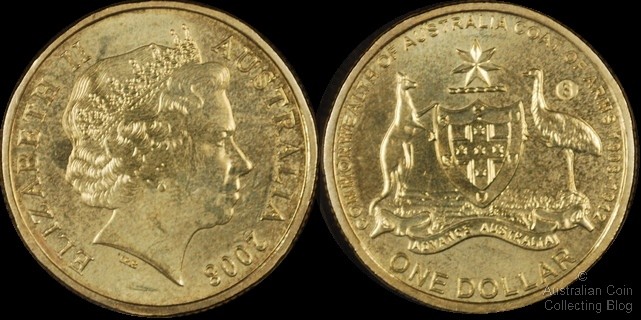
Australia 2008 Centenary of the Australian Coat of Arms Dollar with S Counterstamp
The Australian Coat of Arms is the representative symbol of Australia granted by King Edward VII in 1908. The design has been modified slightly over the years but generally has remained the same. It is used for authentification purposes on official documents such as your passport and is used to identify government property or authority. The most significant change to the COA was in 1912 when the shield displaying the cross of St George was replaced by a version incorporating state emblems. It is interesting to note the kangaroo and the emu that are depicted as our own Australian native animals and the fact that these animals cannot walk backwards is symbolic of the nation moving forward and not backward.
To mark 100 years from when the Coat of Arms was first introduced the Royal Australian Mint released a standard 25mm aluminium bronze 9 gram one dollar coin. This coin was the mintmark coin for 2008 and bears a mintmark, counterstamp or privymark in folders labelled with the type of mark the coin carries. We've written detailed article previously about the differences in these marks and how to identify them when they were first introduced.
The reverse of the coin depicts elements of the original design from 1908. This Coat of Arms is the same as struck on some of our pre-decimal coinage such as the florin and the threepence prior to 1936, the kangaroo and emu supporting the shield on a grassy mound. A seven pointed star is depicted above with "Advance Australia" written in the ribbon device below. The legends read "Commonwealth of Australia Coat of Arms 1908-1912 One dollar". The obverse of this coin features the standard Ian Rank-Broadley effigy of Queen Elizabeth II. Not released for general circulation the coin was released with a C mintmark, S privymark and counterstamp, B privymark and counterstamp, M privymark and counterstamp for $2.75. The counterstamp issues were struck at the various venues on a portable press machine that the RAM took around the country. The C mintmark was the coin struck by visitors on the gallery presses in the Royal Australian Mint building. Take a look at the 2008 Australian dollar mintage table for the numbers issued. This coin was also released with a C mintmark in a silver proof version for $40.
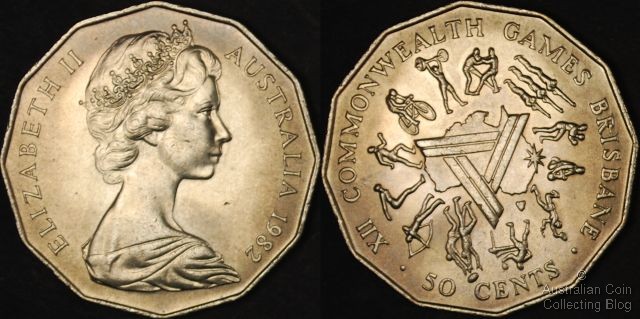
Australia 1982 Commonwealth Games 50c
The Commonwealth Games are an elite sporting event held every 4 years and participant nations come from the Commonwealth of Nations (which was formerly the British Empire). The games have been held since 1930 (when they were known as the Empire Games) and changed name several times until 1978 when they finally became known as the Commonwealth Games. Australia had held the games twice until 1982 when they were held in Brisbane (the 12th Commonwealth Games). As a child at the time of the Brisbane Commonwealth Games I clearly remember the huge winking kangaroo, Matilda, that made it's way around the stadium during the opening ceremony. Putting aside the memories of childhood the games in Brisbane were a very popular event in Australia, with Australia and England having an exciting head to head contest at the top of the medal tally board. To celebrate such a large sporting event the RAM issued an attractive 50c coin into circulation which can be seen above.
The obverse of the 12 sided, 15.5 gram, cupro nickel 50c coin coin bears the standard young portrait of Her Majesty as sculpted by Arnold Machin. The reverse of the coin was designed by Stuart Devlin. The reverse design shows the logo of the 1982 Brisbane Commonwealth Games over a map of Australia surrounded by icons representing 12 of the sports conducted during the games. The legend around the reverse reads "XII Commonwealth Games Brisbane 50 Cents". 23,287,000 of the coins were struck for circulation, a further 195,000 in brilliant UNC condition for mint sets, and 100,000 were struck to proof standards for the 1982 proof sets. The coin was also struck in silver for the 1989 Masterpieces in Silver set, but was dated 1989 and had the newer Raphael Maklouf obverse.
Like the 1970 Captain Cook 50c, the 1981 Charles and Diana 50c and the 1977 Silver Jubilee 50c the 1982 Commonwealth Games 50c was hoarded away in great numbers in the hope that they would someday be worth a fortune. Tragically that day has yet to arrive and you can easily buy a nice uncirculated coin for just $4. A coin from a mint set may fetch a couple of dollars more. A pristine proof 1982 50c could fetch about $20 while the silver coin from the 1989 Masterpieces in Silver set would get about the same. If you're lucky enough to find a circulated 1982 Commonwealth Games 50c in your change please buy yourself a very small chocolate bar with it because it's worth exactly 50c!

Australia 2010 Australia Day 50c Proof in Capsule
Celebrating Australia Day in 2010 the Royal Australian Mint in collaboration with the Australia Day Council has released a commemorative cupro-nickel 50c coin into circulation. With a minimum of 5 million coins planned to enter circulation, expect to find one of these in your change at the shops any day now.
It wasn't until as recently as 1994 that the whole of Australia has consistently celebrated Australia Day on the 26th of January as a public holiday. It was on the 26th January 1788 that The First Fleet from England landed at Sydney Cove and raised the Union Jack founding the Colony of New South Wales. Whilst not always called Australia Day, the 26th of January has historically been used for celebrations and commemorations. It has been known as Foundation Day, Anniversary Day and also Invasion Day.
In today's society Australia Day is a day to celebrate being Australian and what it means to be Australian. The Day is intended to bring all our diverse cultures together and remember our Aboriginal heritage to be proud Australians. Capturing this theme for Australia Day 2010 is this new dodecagonal 50c which tells us to "Celebrate What's Great" and come together to reflect on the past, present and future. The coin features a map of Australia made of ribbons with proud Australians young and old banded together by these ribbons. "50" is depicted inside the map with "Celebrate What's Great Australia Day" as the legend around the map.
The reverse design is sculpted by RAM designer Vladimir Gottwald, it's obverse the standard Ian Rank-Broadley effigy of Queen Elizabeth II. As well as being found in circulation this coin is also being released in RAM wrappered commemorative mint rolls for $19.95. It is also being released in a selectively gold plated silver proof version in a plush case for $85. The selectively gold plated proof (seen above) features the map of Australia in gold plate and a mintage of just 10,000 coins.
The RAM have produced a short clip to view these proof coins in production. This clip can be seen on their website. (note: your speakers aren't broken, there's no sound!)

Australia 1981 Royal Wedding Charles and Diana 50c
Prince Charles is the eldest child of Queen Elizabeth II, first in line to the throne and potentially the next King of England and the Commonwealth. Nuptials between Prince Charles and Lady Diana Spencer took place on 29th July 1981 (which was named a national holiday in celebration) in front of a worldwide TV audience of 750 million people. It was labelled a fairytale wedding as Diana was the first British commoner to marry an heir to the throne since the 1500's. The couple were dominant public figures constantly under scrutiny from royal watchers. They later had 2 children, 2nd in line to the throne Prince William and 3rd in line Prince Harry.
In Australian up until as close to the event as June 1981 it wasn't clear that a commemorative issue was even going to be released with industrial action at the Royal Australian Mint affecting coin issues and the minting process. However, after keeping their plans under wraps the RAM finally announced that to celebrate this royal marriage the Royal Mint in Wales was to strike a commemorative 50c piece to circulate in Australia. Designed by Stuart Devlin the reverse of this coin features profiles of Charles and Diana (known as jugate) facing left with the legends reading "HRH The Prince of Wales and Lady Diana Spencer Fifty Cents". This was an official design given the Royal seal of approval by the Queen but is affectionately known to collectors as the Chuck and Di 50c.
The obverse bears the Arnold Machin portrait of a young Queen Elizabeth II (used from 1966 through to 1984). 20 million of these 15.5 gram cupro-nickel coins entered circulation but they are not that easy to find in your change as a lot have been hoarded in money boxes and jars. It's not uncommon to find high grade coins because if this hoarding and they don't gain much premium if any over their face value of 50c.
These coins were restruck in Canberra as a silver proof version which was included in the 1989 Masterpieces in Silver Sets.

Australia 2005 Melbourne Commonwealth Games 2006 50c found in change
"United by the moment" was the motto for the 18th Commonwealth Games held in Melbourne, Australia in 2006. Every 4 years since 1930 (excepting during WWI in the 1940's) nations of the Commonwealth compete together in events such as aquatics, gymnastics, cycling and shooting. For eleven days in March 2006 spectators and athletes flocked to Melbourne venues to watch and compete. Australia won 84 gold medals finishing at the top of the medal tally board for all the Commonwealth competitors.
To celebrate this event the Royal Australian Mint released a commemorative fifty cent into circulation. Just to confuse you the coin is dated 2005 on the obverse but features "Melbourne 2006 XVIII Commonwealth Games" on the reverse. This coin as shown above was designed by 16 year old Victorian Kelly Just who won a nation-wide secondary school competition to design the reverse. Kelly's original design was then sculpted by Vladimir Gottwald but the coin bears the initals "KJ". Kelly's reverse design depicts animals mimicking athletes as they are competing in the Games symbolic of the embracing spirit of the games and Australia's unique fauna.
This standard dodecagonal cupro-nickel 50 cent piece weighs 15.55 grams at 31.51 mm in diameter. It features the standard Ian Rank-Broadley effigy of Queen Elizabeth II. 20.478 million of these coins entered circulation so they are not hard to find in your change. 24,806 carded unc coins were issued separately for $7.50 each. This coin was also included in a foldered collection of uncirculated coins featuring all the NCLT (non-circulating legal tender) commemorative 50c coins issued for the games and a $5 coin with a mintage of 15,500 folders for $99. A 99% silver proof version was also issued.
A circulated coin pulled from your change would be worth.......50c!
I'll confess that I quite like the idea that I can make money with my coin collection. This could be by buying a top coin, holding onto it for years and then selling at a profit, or perhaps spotting a bargain, snapping it up, and turning it over immediately for a quick profit. However, like so many things, when the potential for profit (or loss) is at hand common sense and logic seems to fly completely out the window. One well known online coin forum has two interesting discussion threads running at the moment. One is about supposedly over-priced Royal Australian Mint collector coins and the other about the sudden surge price in the secondary market of a particular dollar coin.
The opinion of one group of people is that the RAM overprices a certain product and the potential for future investment gains is extremely limited because of the high purchase price. Their solution would be for the RAM to release said product at a much lower price in spite of the fact that the lower price suggested would most likely be well below the actual cost of materials of the product!
Let's have a quick look at the second issue, a NCLT dollar coin with a high mintage and low issue price (around $13 I think). The coin was released a couple of years ago and some recent events have lead to a surge in the price of the coin on the secondary market. This has lead to cries of profiteering and sellers hyping a coin to push the price up.
Now funnily enough the group of people who are upset about the lack of potential investment returns in the first 'over-priced' release from the RAM are THE SAME PEOPLE who are upset about the price rise in of the second much lower release cost coin from the RAM. One can only guess why this is the case, perhaps they bought some of the 'expensive' release that has bombed and didn't get any of the 'low cost' release that has boomed? When dollars get involved in the thought process logic seems to fly out the window!
Now I should state my position here, I own both of these releases, one has bombed and one has boomed and honestly I am happy with both items. They are attractive and I wont be selling either any time soon. But neither is an 'investment', they are part of my collection, I enjoy them, and that's what makes me happy. I'd like to think a lot of coin collectors out there think the same that I do.
So you're interested in collecting Australian coins and want to know how to get started? Here's my top 10 tips for the new collector of Australian coins.
- It's often said about collecting coins, and I'll repeat it now. Buy the book before you buy the coin. Get yourself one of the two well known Australian coin catalogues, either McDonalds or the Renniks catalogue.
- Take a deep breath and calm down. There's no rush to get in there and start buying right now. Take the time to see what's available, what interests you, the different ways you can purchase and the different places you can purchase.
- Try to visit a coin shop. Look at coins up close, hold them, look at RAM products and how they are packaged. Coin collecting is very tactile and visual, and while the Internet has given coin collectors the opportunities to purchase more easily than ever before it can be a remote and unemotional process. Entering a coin shop for the first time can be a huge thrill!
- Don't get excited or caught up the dreaded auction frenzy when buying coins from sites such as eBay. Recently people were paying more than $100 for coins that cost $3 from the RAM in Canberra. These same coins will be minted ALL YEAR and be available ALL YEAR for $3 from the mint. I pity people who paid that much money for a coin that will be worth $4-5 by the end of the year.
- Try to wait a year before buying current issue RAM products. It's not unusual to see mint sets and proof sets to be selling on eBay and similar sites for well under issue price the year after they are issued.
- Make sure you store your collection the right way from day one. If you collect RAM product then make sure it's kept protected in storage boxes away from prying little hands. It seems silly but a proof set with a daggy damaged box but perfect coins will always sell for less than one with a pristine box. If you're collecting individual coins make sure you choose a PVC free storage solution for them, it's no more expensive and you'll stop your coins from being ruined in the long run.
- If you've decided to collect pre-decimal coins then you need to learn to grade. Now. No, not later, now! If you don't take the time to learn to grade then you're going to be at the mercy of the seller of the coin and the grade he or she assigns to a coin. When just one or two grades difference can mean tens, hundreds, or even thousands of dollars in difference in value you can see it's well worth your time! The ANDA Grading Guide for Commonwealth Coinage is a good place to start, as is a dealers stock book. If you don't want to learn to grade you could just collect slabbed Australian coins but even then you SHOULD learn to grade so you know what you're buying.
- Don't think you're 'investing' in a coin unless you are highly knowledgeable about the market, the coin series and can grade the coin accurately. If you're not all of these things you're just speculating and just as likely to do your dough as make money. Even if you are all of these things sometimes you're just speculating in a more educated fashion!
- Get involved with the coin collecting community, you'll pick up handy tips, make friends and keep abreast of the current market conditions. Coin clubs, online coin forums and coin shows are ideal ways of getting involved. Coin collecting is by it's nature a solitary hobby and if you make the time to talk to others it is entirely more enjoyable.
- Remember it's supposed to be fun. If the hobby stops being fun the step back and re-evaluate what you're doing. If you're worried about financial returns then it's not a hobby and you should examine your motivations. If a collecting theme is boring you then look for another. If you're out of money look for a coin collecting book to read instead!
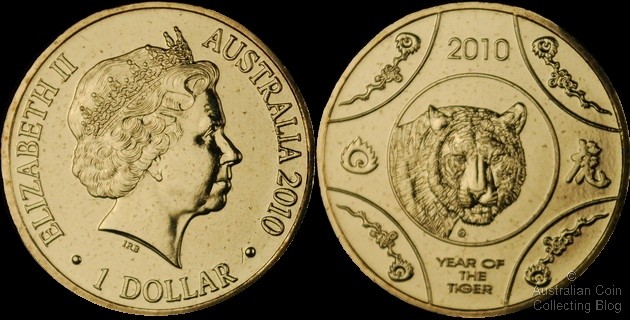 2010 Unc Year of the Tiger
2010 Unc Year of the TigerIn 2010 the Royal Australian Mint continues their lunar series following the Year of the Ox release last year with the 4th in an ongoing series of NCLT (non-circulating legal tender) one dollar coins depicting each lunar year and their representative animals. Intended as a collectors coin this 2010 $1 marks the birth of a loved one or a birthday gift for those born in the year of the tiger which begins on February 14th 2010. Those born in 1998, 1986, 1974, 1962, 1950, 1938 or 1926 were also born into the year of the tiger. A dominant trait of those born into the year of the tiger is enthusiasm, courage, resilience and friendliness. The Chinese believe that each zodiac animal has a profound influence on the personality and destiny of each person born into that zodiac year. Faults of those born into this lunar year are suspiciousness, selfishness and indecision.
The Year of the Tiger one dollar design by Vladimir Gottwald features a Tiger with authentic chinese symbols all in a symetrical design on the reverse. It also features Gottwald's initial as the designer of the reverse. The coin is issued in a protective capsule housed in an informative card. This card features a red and gold design, the traditional colours of good fortune in Chinese culture. The coin features "2010 Year of the Tiger" on the reverse and, different to other standard dollar issues, states the denomination "1 Dollar" on the obverse below the portrait. It is the standard 25mm size, 9 gram, aluminium bronze one dollar coin with the Ian Rank-Broadley effigy of Queen Elizabeth II.
This year of the Tiger one dollar is issued in uncirculated condition for $12.95. The design is also issued also in a 99.9% silver proof (11.66g) with a mintage of not more than 10,000 for $45 and (1/10oz 17.53mm) $10 gold proof coin for $260 with a capped mintage of 2,500. See the dollar mintages in the 2010 $1 mintage table.
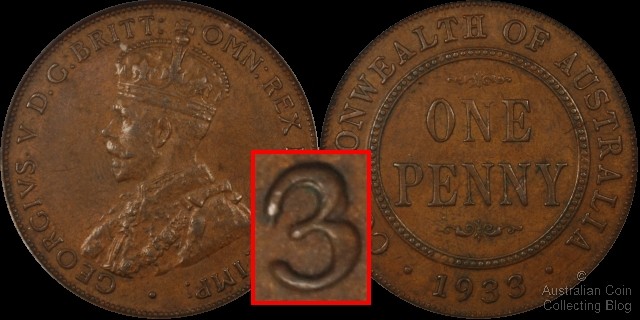
Australian 1933/2 Overdate Penny
A particular type of coin variety is the overdate. Put simply an overdate is a coin struck from a die that has a trace remnant of a previous years numeral in the date. Among Australian copper and silver Commonwealth coinage there are 4 known overdate issues, the 1922/1 3d, the 1925/3 1s, the 1933/2 1d, and the 1934/3 3d. The image above shows the 1933/2 overdate penny with the last 3 of the date expanded. You can see clear traces of the underlying 2 extending from the end of the top loop of the 3 and from the front and back of the top loop of the three, There are a number of overdate issues available among the gold Commonwealth issues of the 19th century. As far as I understand there are 3 different ways that an overdate working die can be produced:
- A master die or punch is re-worked to show the new date and traces of the old date remain when working punches are produced from the masters.
- A working punch is reworked to show the new date and traces of the old date remain when working dies are produced from the working punches.
- An existing working die is re-engraved, re-punched, or hand stamped to show the new date and traces of the old date remain when coins are minted from the die.
Looking at the Commonwealth overdate issues and their relative mintages it isn't hard to postulate how each issue was produced. The 1922/1 3d is an extremely low mintage coin, less than 1500 issued so may be the product of just one re-worked production die. The 1933/2 penny and the 1934/3 threepence comprise just a fraction of the total mintages for the year but enough to suggest that one or more overdate working dies were produced and used to make coins during those years. Jon Saxton at Triton Coins suggests that the 1933/32 penny working dies were formed by hobbing existing 1932 penny working dies with a 1933 penny punch. He goes onto suggest that a similar process may be responsible for the entire 1925/3 shilling production. Jon also has an excellent description of how the 1922/1 over date threepence die may have been produced which you can read here.
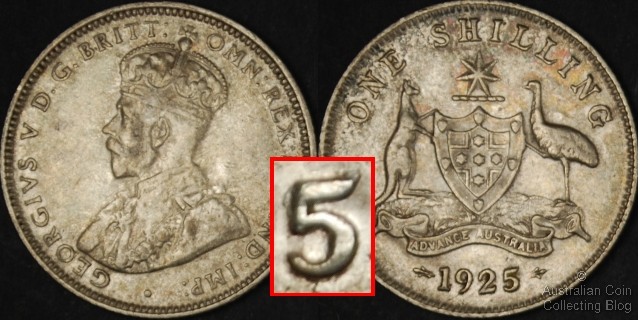
Australian 1925/3 Overdate Shiling
Above you can see a 1925/3 overdate shilling. The overdate on these can be a little difficult to spot but if you look closely at the expanded 5 of the date you can see the end of the top loop of the 3 protruding from the top left of the 5.
The Royal Australian Mint in Canberra displays a wide range of coins in their museum on the first floor of the newly refurbished building. Amongst the coins on display is a variety of error coins or mistakes that have happened to coins during production. We're lucky to have some of these coins on display because it's quite rare that coins of this nature would pass by the strict quality control to exit the mint and enter circulation.
The 20 cent proof shown below is one of those coins that jammed the machine and was never capable of exiting the press. One of the feeder fingers which feeds the blanks into the press has malfunctioned and the pressures of the strike have welded the feeder finger to the coin. The press would have needed to be dismantled to fix this coin jam.
Major whoops 20c Proof
The Australian commemorative dollar shown below is termed a "die cap". It failed to be released from the press, adhering to the upper hammer die. It was this "capped" coin that struck the subsequent coins. The blanks fed through while the cap was in place struck on this die cap and would exit the press as brockage errors showing the mirror image of the design on the reverse. The more brockage errors the die cap strikes the higher and deeper the cap becomes before breaking from the hammer die.
2009 Citizenship $1 Die Cap Error
We've spoken before about double struck coins and this example is a beautifully toned magnificent example of a double struck 10c. A struck coin failed to eject from the press completely and was struck for a second time. This produced an elongated planchet with half of the coin design depicted twice.
10c Double Strike
For an update and more errors, have a look at part 2 of this article.
Question:
Could you please explain to me why the 2000 $1 MOR coin ( not the mule) is so expensive when compared to other $1 coins around the same time. In Greg McDonalds 17th issue, it shows this coin around the $50 mark for an unc coin? Is this correct,Regards.
Answer:
Hi, Greg McDonald hasn't updated his pricing (regarding this coin) for a few years. It's the same as listed in the previous edition. Greg's pricing isn't always concurrent with the market and if you have an interest in a particular coin and follow what they are going for you'll notice there are often differences to the catalogue value. Renniks 22nd tells me this coin has a cv of just $25 in unc. Of course sellers are going to quote the highest cv or use the highest cv to get the best sale price.Greg McDonald often uses other people eg.dealers to keep his pricing up to date as you can imagine it would be a mammoth task to keep up to date. Let's just consider one idea for a moment. If Greg had asked Dealer X to give him the numbers a few years ago and Dealer X happened to be sitting on a large hoard of these coins then wouldn't they try to artificially inflate the price?
Of course the 2000 dollar was a low mintage year and it wasn't expected to be. There were also a lot of tourists in the country for the Olympics which may mean a lot of dollars left the country in pockets. Note the Mint and Proof Sets for this year have a high cv due to the tourism influx. This is the only other way to get a 2000 MOR $1, the rest being in poor circulated condition by now, maybe this has determined the high cv.
Note the cv for the roll is $700 which seems crazy. But to find an unc mule in a roll would be worth maybe $8,000+. I haven't seen any rolls sell lately but if they do get that much money because of the potential mule find then maybe the high cv for the single coin is relative to that?
It's all just speculation.
Kind Regards,
The australian-threepence.com blog team
Please note that in the interest of anonymity we always remove names so that we can share our questions and answers with everyone.
If anyone has been to the new Royal Australian Mint visitor centre next door to the old mint building you'll be pleasantly surprised to find fantastic viewing opportunities for visitors to watch coins being struck, packed and moved around the facility. The visitor is presented with a vast expanse of production viewing, displays, a theatrette, the Mint shop, 2 gallery presses and a cascade of 5c pieces down the staircase. With the large expense of preparing the new facility I would have thought the Mint would have put some more thought into the displays in their museum on the first floor with coins on show from the Mints' National Coin Collection as well as displays illustrating the history of Australian coins.
There are some beautiful and magnificent coins on display from our proclamation heritage to spectacular error coins and pattern and test coins that didn't make it into production. The questions I have though is that why are coins with such significance to our national heritage not protected or stored correctly to ensure the preservation of the coins for the future. Coin storage is a passion of mine and when wandering through the displays at the new Mint building I am horrified at the way some of their coins are being stored, housed and displayed.
Below we have a leather wallet presented to Prime Minister Sir Robert Menzies. The wallet, with 1966 coins inside bear the initials R.G.M obviously in very original condition with green verdigris growing on the coins inside.
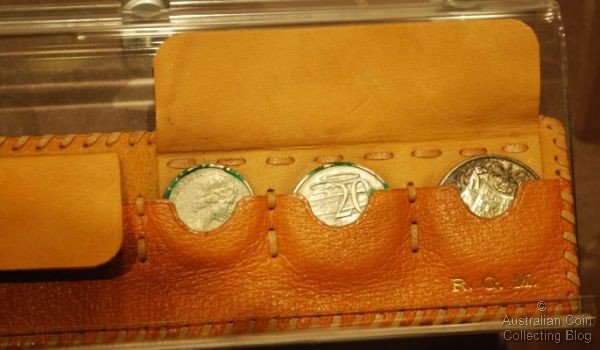 Leather Wallet presented to the Prime Minister
Leather Wallet presented to the Prime MinisterA lot of special coins are displayed on small acrylic "shelves" for want of a better word. A small 1894 Great Britain Maudy Penny is too small to be held up by the notch in the acrylic stand and is held in place by blu tack!
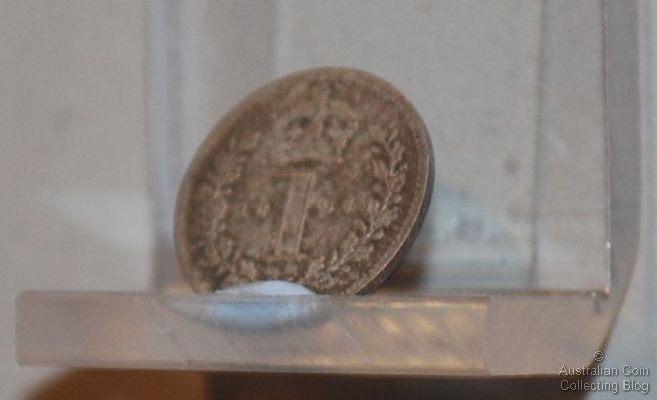 Small coin display held up by Blu Tack
Small coin display held up by Blu TackUnprotected coins of significant value lay loose in cabinets willy nilly.
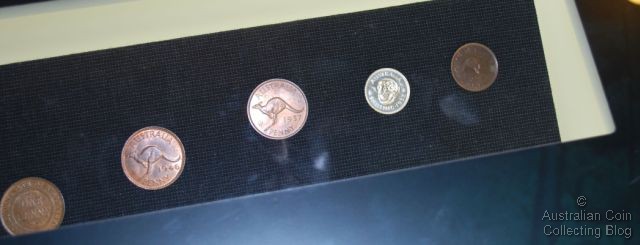 Left to right: unc 1925 penny (c.v $17,500), unc 1946 penny (c.v $3,500), 1937 penny (c.v $250,000+), 1937 shilling ( c.v $195,000) and a proof 1939 (roo) halfpenny (c.v $40,000).
Left to right: unc 1925 penny (c.v $17,500), unc 1946 penny (c.v $3,500), 1937 penny (c.v $250,000+), 1937 shilling ( c.v $195,000) and a proof 1939 (roo) halfpenny (c.v $40,000).A display noting mintmarks points to a 1945 penny with a "P" mintmark. Whilst there is no image available for this, we all know the mintmark is a dot after the Y for most Perth minted coins. Our tourist visitors inspecting this coin would be scratching their heads to find that elusive "P" mintmark.
Displays of our newest decimal commemoratives show an extreme lack of imagination. Coins in cheap capsules glued to strips of black cardboard display our nations coins to the bus loads of tourists visiting the Mint. One can hope that these displays are only temporary and more permanent and appropriate housing for these coins will be produced in the near future.
edit: (20/03/2010) The display of these coins at the RAM has been improved, this display was temporary.
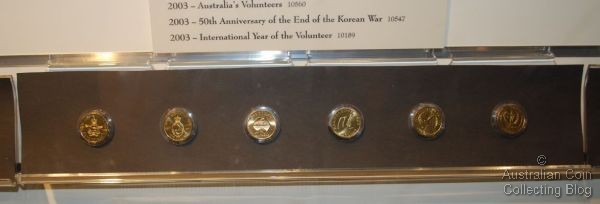 Permanent coin display?
Permanent coin display?We know the original vinyl packaging for mint sets is detrimental to the health (you did know didn't you?) of the coins it houses. Coins in these PVC packs get slimy and green, this slimy film etches into the coin surface over time destroying it. These sets need to be displayed, yes, but in a way that protects these coins for the future to see without damaging the coin and destroying it's appearance.
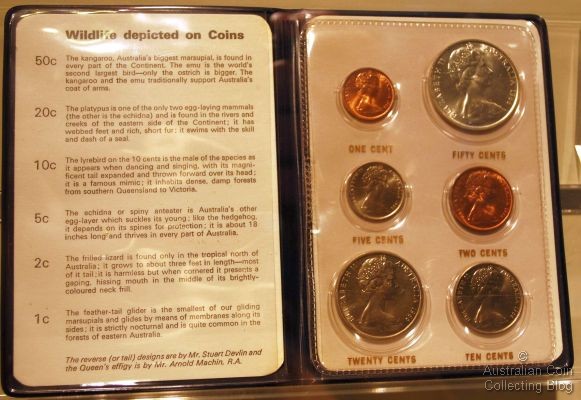 Early Mint Sets in PVC Wallet
Early Mint Sets in PVC WalletThe lack of proper archival storage techniques for the coins in the mint displays is shown with damaged pieces clearly in need of some TLC.
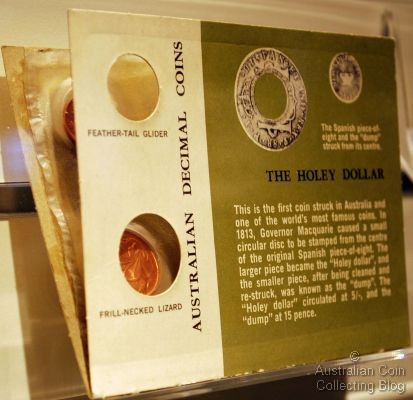 1966 card in need of some archival grade tender loving care
1966 card in need of some archival grade tender loving careAnother set clearly not the finest specimen to be depicting this mass produced private release of the new circulating decimal coins in 1966.
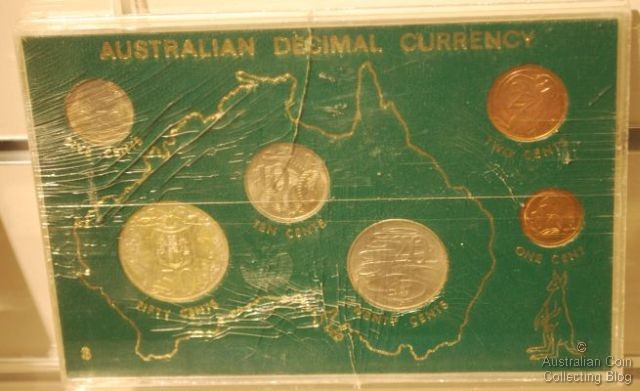 Non-RAM mass produced set incorporating circulated coins
Non-RAM mass produced set incorporating circulated coinsWhilst there is a display still awaiting completion we can only hope that advice is sought and displays at the new Royal Australian Mint building are altered to preserve our coins and our heritage and history for future generations to appreciate.
I have been dwelling on this all week and I'd like to candidly write (that is what blogs are for) about my experience in the queue to mint the first dollar coin for 2010.
When all the keen collectors entered the Royal Australian Mint punctually at 10am, New Years Day 2010, quite a few collectors donned their white cotton gloves in preparation for striking their coins. I had forgotten my gloves but had stopped at the supermarket on the previous day and picked up a packet. There were 4 gloves in the packet and 2 friends I had gained in the queue who had come ill prepared so I gave a glove to each and some money bags I had picked up from the bank. Number one in the queue donned his white gloves, struck his first coin and subsequent coins were put into baggies for later placement in 2x2's. This is how I was going to do it and my friend and I went tag team, me with the gloves and him putting money into the slot. There was a guy a few people back in the queue who asked to use the gloves also so I gave him the last spare glove, he was very very grateful for this.
Helen, the Mint shop manager who was managing the queue saw the white gloves come out and and watched as other people got out tissues to pick up the coin with so as not to touch the coin surface. She dashed off and brought back clean paper towels from the bathroom and money bags from the shop for everyone who was starting to follow the lead from those in front with concern over putting the coin in the folder and how this damages the coin over time. I have to congratulate Helen for seeing the need and responding with a solution showing concern for the well being of the coin and ensuring that they were handled and stored correctly.
This brings me to my ultimate pang. There was a young boy with his Dad who had been waiting in front of me in the queue since about 4am I think. He got to the press to mint his coins and pulled out his 30 pocket pvc coin page and slipped each coin into the slot in the page as he struck the coin. My heart sank. This boy was obviously passionate about collecting and Dad was helping out his son with his interest and they had been waiting for hours to be one of the first to get the new 2010 dollar. To my disappointment these coins are now consigned to a pvc page to die a slow green death and become worth no more than the dollar of face value each holds.
Why do dealers still sell these pages when they know the damage this kind of storage does to coin collections? The only reason I can think of is that it's a cheap storage method. No need for the extra expense of holders or 2x2's, but it's to the detriment of the coin. I feel upset that dealers sell these types of pages simply because they are cheap. The uneducated collector or young collector is going to go for the cheapest option and if they are sold in the coin shops they must be safe for a coin...right? Wrong.
It's time for coin dealers to look beyond the very small profits that they make from selling cheap and harmful coin storage accessories and think about the long term welfare of their customer's collections. The Purple Penny and their archival quality PVC free coin accessories have a small voice in Australian coin collecting circles and some of the larger coin collecting personalities in this country have openly scorned the idea of archival quality coin accessories. I can only think that if these 'numismatists' cared more for the long term health of the coins they sell then the hobby would be a better one for all of us, both new collectors and experienced ones.
Australian coins you find in your change can have more value than their stated denomination and if you've done your homework and know what to look out for you can take advantage of this. Values for Australian collector coins and those not intended for circulation can and often do have a much higher value than their circulating cousins.
A lot of people and many people who contact us have a variety of new and old coins lying around and they want to know how much they are worth. This blog is a great place to start and we've gathered quite a lot of interested readers who read our posts about all sorts of numismatic topics.
A great place to start to find out about the value of your Australian coins is the latest 17th edition of Greg McDonald's 2010 Pocket guide to Australian Coins and Banknotes. This catalogue ranges through early proclamation coins, pre-decimal coins, decimals and banknotes. If you have a coin shop or dealer nearby then it's also worth stopping by and showing them what you have because grading a coin accurately can sometimes mean the catalogue value differs by of hundreds of dollars.
Correctly identifying your Australian coin is very important when determining its' value. Sometimes the same coin may be available in several different types of packaging or the same design might be struck in a different metal and with a different face value. This is where the catalogue, our blog articles or a Google search will help you narrow your search down to find the value of your coin. We have a whole series of one dollar articles to help you identify and value your Australian one dollar coin correctly.
Valuable coins can be found in your change and it's worth educating yourself so you know what to look out for. Avid collectors always check their change when they get some hoping to be lucky and get a 2000 $1/10c mule , a wavy baseline 20c coin , an upset federation dollar or an millennium incuse flag 50c coin.
Often unique pieces emerge through accidents at the Mint. Mostly these are picked up before the coins leave the facility but the odd one slips through. We've labelled these extreme decimal rarities and they are very hard to come by. Mostly these are accidental and fall into the category of error coins. These accidents might occur due to mechanical failures, human error, or flaws in the raw material of the coin itself. They can often be very spectacular coins, you can see such interesting coins made incorrectly in a display which is in the visitor gallery at the Royal Australian Mint in Canberra.
Other rare coins found in change might just be those with a low mintage or minor varieties which might just command a small premium over face value.
When decimal currency was introduced in 1966 our 50c was a round version made of 80% silver. Whilst not rare coins by a long shot, these coins have been hoarded by the public because of their silver bullion value. They are worth well over their face value of 50c today, the exact value fluctuates with the bullion trade.
We were lucky enough to watch the toolsetters changing over the dies on one of the gallery presses late in the afternoon of New years Eve. The fitters worked on press 2 before the closure of the facility while visitors were still able to press the 2009 coin on press 1.
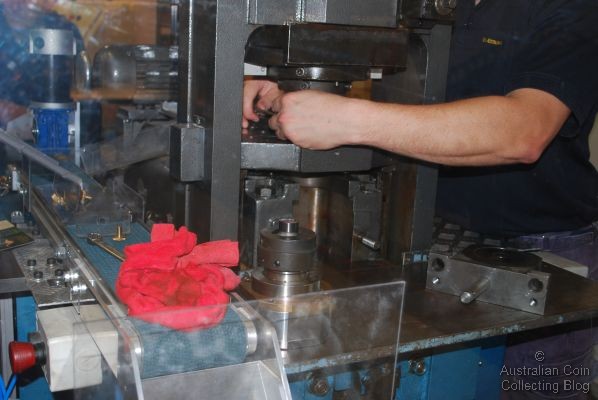 Changing the Dies for the New Year
Changing the Dies for the New YearThey needed to change both the reverse and obverse dies for the new 2010 coin with the third collar die remaining untouched.
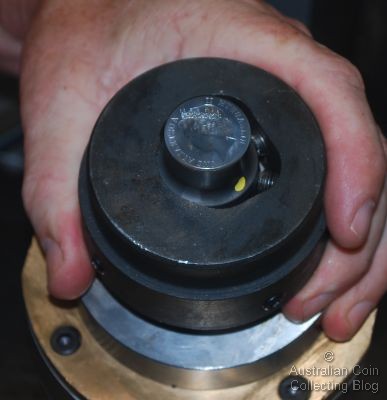 Obverse die for the 2010 Gallery Press 2 $1
Obverse die for the 2010 Gallery Press 2 $1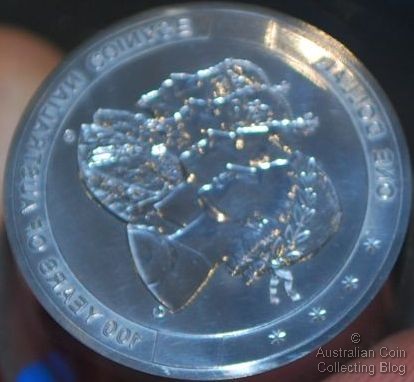 Reverse die for the 2010 Gallery Press 2 $1
Reverse die for the 2010 Gallery Press 2 $1The reverse and obverse dies can only be set into the press one way (to prevent upset coin errors) but the collar die angle varies each time it is removed and reset. For the new year, differences in the angle of the collar die can be seen for each of the 2 presses. We can therefore differentiate which press struck each coin creating what some collectors would term a variety. This will be accurate of course until the dies are changed or the collar die is reset and it is entirely unknown how often and when this may happen. It may happen at regular intervals or it may happen because of press breakdown or die failure.
Collar die variations or reeding position differences can be seen in the image below. Of course this is only accurate for coins pressed on 1 January 2010, if the dies have changed or been reset since this time the reeding positions may be different.
 Gallery Press 1 (left), Gallery Press 2 (right)
Gallery Press 1 (left), Gallery Press 2 (right)Dollars struck on press 1 (closest the main entry door) have the edge reeding start between the A and the U of Australia on the obverse. Dollars struck on press 2 show the A of Australia begin 1/3rd through the reeding.
Acting RAM CEO Mr Graham Smith was kind enough to speak to us on New Years Day at the mint regarding his future plans. After CEO Janine Murphy fell ill more than a year ago Mr Smith stepped up as the acting CEO of the RAM. Janine's passing in September 2009 has meant that a new more permanent CEO will need to be selected but it seems this is a slow process in the public sector.
We are told that early in the new year steps will be taken to appoint a permanent CEO (formerly known as Mint Controller). Whilst Mr Smith will throw his name into the hat, we got the impression from him that a fresh face would be chosen for the job. Mr Smith was positive about the possibility of continuing on as Deputy CEO at the mint.
Let's hope that as changes are made and new ideas and decisions are brought to the RAM that it only benefits the country, the economic climate and most of all the collectors.
We hope that whatever choice is made for the new CEO that they will be open to input from collectors about issues such as:
- The number and quality of coin issues
- Allocation of low mintage issues like the Kangaroo at Sunset coins
- The RAM and portable press attendance at Coin shows
These are just a few of the problems that collectors see that may well be addressed differently as the RAM moves forward into the new decade.
You're probably intimately familiar with the echidna on the our 5c coin, the lyrebird on our 10c coin, the platypus on the 20c, the coat of arms on the 50c coin, and 5 kangaroos on the renowned mob of roos $1 coin. All of these designs were sculpted by Stuart Devlin, the well known silver smith, coin designer and jeweller to the Queen. Devlin designed the $1 reverse in 1984 while the other coins were designed by him in the early 1960's for the decimal changeover on 14 February 1966. As is quite common Devlin marked his coin designs with his initials, and if you look closely at the reverse of the coins you'll still see his initials there more than 40 years after he designed the coins (other than the $1 coin).
However, unless you're a dedicated coin collector you probably do not know the names of the talented coin designers who are responsible for the many collector coins that are released each year. You probably don't even know their initials! The Royal Australian Mint seems to have stopped the practice of allowing the designers of the reverses of their coins to sign their work. In fact we believe the practice largely stopped in 1989 when Horst Hahne's initials disappeared from the reverse of the $2. There seems to have been odd issues in the intervening years that had the designers initials (such as the 2000 Sydney Dollar, the 2005 Dancing Man dollar). Oddly the initials of the designers of the obverse of Australian coins has continued to appear uninterrupted. It certainly seems a shame that talented artists such as Vladimir Gottwald, Wojciech Pietranik, Caitlin Goodall are not seeming to receive the consistent credit they deserve. However, we've noted that in the issues of the last 18 months or so that the designers initials seem to have re-appeared on the reverses of our coins. Here's a list of dollar coins we've seen initials on.
- 2007 Peacekeepers Dollar - CG below right hand holding globe
- 2008 Scout Dollar - CG under the second A in Australia
- 2008 Year of Planet Earth Dollar- Incuse G at 4.30 next to rim
- 2008 Quarantine Dollar - WP in western Victoria on map of Australia
- 2008 MacKillop Dollar - Incuse G under hand of rightmost child
- 2009 Year of the Ox Dollar - incuse G under ox neck
- 2009 Astronomy Dollar - CG under fence on far right
- 2010 Year of the Tiger Dollar - incuse G next to tiger neck
- 2010 Centenary of Australian Coinage Dollar- incuse G under Edward VII portrait
- 2010 Burke and Wills Dollar - WP under dig tree
So if you're wondering what the designers initials look like, then see the image below.

WP Wojciech Pietranik (left), Incuse G Vladimir Gottwald (centre), CG Caitlin Goodall (right)
So if you get a shiny dollar coin in your change (and it's not a mob of roos) or buy one of the new collector dollars from the RAM why not give yourself a minutes entertainment by taking a closer look and see if you can spot the designers initials.
 1999 Last Anzacs Dollar
1999 Last Anzacs Dollar1999 saw the release of yet another military themed collector dollar coin by the Royal Australian Mint. 1999 was 84 years since the landings of allied troops in the Dardanelles in Turkey, and in particular the landings of Australian and New Zealand troops at Gallipoli (an event we covered in our entry on the 2005 Gallipoli Dollar. By 1999 even a boy who had lied about his age to join the army at 15 or 16 would be 100, and sadly, veterans of Gallipoli were very few indeed. To acknowledge their sacrifice and valour (and that of other veterans of Australia's conflicts since nationhood) the Federal government ran a commemorative program in 1999 called Their Service - Our Heritage and the RAM released the 1999 Last ANZACS dollar as part of this program.
The RAM issued the Last ANZACs dollar as standard sized 25mm, 9 gram aluminium bronze coin with the Ian Rank-Broadley portrait of QE2 on the obverse. The reverse sculpted by Wojciech Pietranik, shows a 'digger' (the nickname Australian soldiers quickly gained in WW1) in his iconic slouch hat.
The Last Anzacs dollar was the mintmark dollar for 1999, mintmarks issued were a C for Canberra (126,161 minted), S for Sydney (53,286 minted), B for Brisbane (33,634 minted), A for Adelaide (28,681 minted), and M for Melbourne (49,841 minted). Some of the C mint marked coins were minted on the public presses at the mint in Canberra, while the remaining mintmarks had some coins minted on portable presses at Royal shows in their respective cities. The exact mintages of the portable press coins is unknown. Each mintmark coin was released in an attractive folder, with a different folder produced for each mintmark. 56,065 of the total mintage of C mintmark coins were also released in a 2 coin folder with the 1999 Year of the Older Persons dollar. 25,000 of the coins were struck in pure silver to proof standards and released onto the collector market.
Very interestingly 47,830 of the Last Anzac dollars were struck with 2000 dated dies for a PNC release with Australia Post. These non-mintmarked coins are all dated 2000 and are not included in the mintages mentioned above.
Lest We Forget : The last ANZAC, Alec William Cambell, died on 16th May 2002. Alec lied about his age when he joined the army and was aged just 16 years and 4 months when he enlisted in July 1915 and he landed at Gallipoli on 2 November 1915.
If you collect coins then the refrain 'learn to grade coins' probably goes around your head like a broken record. If you're going to submit coins to PCGS or some other third party coin grading companies don't go thinking that this negates the need for you to grade your own coins. As far as I am concerned it makes it doubly important. We've just posted up an article over at The Purple Penny on the importance of grading coins for yourself. Please go over there and take a look, I'd like to think it's well worth a read!
 Unc 2009 Year of the Ox One Dollar -obverse left, reverse right
Unc 2009 Year of the Ox One Dollar -obverse left, reverse rightIn 2009 the Royal Australian Mint continued with an on-going series of NCLT (non-circulating legal tender) one dollar coins depicting each Lunar year and their representative animals. Intended as a collectors coin this 2009 $1 marks the birth of a special little one or a birthday gift for those born in the Year of the Ox which occurred in 1973, 1985, 1997 or 2009. A dominant trait of those born into the year of the Ox is leadership, dependability, meticulousness and determination. The Chinese believe that each zodiac animal has a profound influence on the personality and destiny of each birth year.
The Year of the Ox one dollar design by Vladimir Gottwald features an Ox with authentic chinese symbols all in a symetrical design on the reverse. The coin was issued in a protective capsule housed in an informative card . This card features red and gold design, the traditional colours of good fortune in Chinese culture. The most unusual characteristic of this issue is that it features "2009 Year of the Ox" on the reverse and states the denomination on the obverse. It is a standard 25mm size, 9 gram, aluminium bronze one dollar coin with the standard Ian Rank-Broadley effigy of Queen Elizabeth II. The legend on the obverse of the lunar series dollars differs from the normal $1 obverse adding the denomination "1 Dollar" below the portrait.
This year of the Ox one dollar was issued in uncirculated condition for $12.95. It was also issued as a 11.66g silver proof striking for $45 with a capped mintage of 10,000. The same design was also issued in a (1/10oz 17.53mm) $10 gold proof coin for $235 with a capped mintage of 2,500.

Australia 2010 100 Years of Australian Coinage Dollar
The authors of this blog were lucky enough to be amongst the first 100 or so people in the world to own the new 2010 Australian dollar coin celebrating 100 years of Australian coinage. If you're not sure what this anniversary means then you should take a look at our blog entry on the 100th anniversary of silver coinage in Australia. It would be cheeky of us to suggest that the Royal Australian Mint followed our lead by issuing a coin with this subject matter, and of course they didn't. But it was obvious given the importance of the event that the RAM would release a coin to celebrate it.
The coin above was minted on the gallery presses at the RAM in Canberra and shows the C mintmark on the reverse. This standard sized 25mm, 9 gram $1 coin is a non circulating collector (NCLT) issue that is available in informative card (which for this coin doesn't seem to be designed to be folded). The obverse is the standard QE2 portrait as sculpted by Ian Rank-Broadley. The extremely attractive reverse is sculpted by RAM designer, Vladimir Gottwald. It depicts the 4 right facing portraits of the four English monarchs that have appeared on Australian Pre-Decimal coinage. From left to right you can see Queen Elizabeth II, George VI, George V, and Edward VII. The legend of the reverse reads "One Dollar" and "100 Years of Australian Coinage" and depicts 4 stars presumably representing the 4 depicted monarchs.
This C mm coin was also released jointly with Australia Post in a PNC. A C counterstamp was also struck on the mobile press at the Canberra ANDA show.
The RAM also released a 4 coin mintmark & privymark set housed similarly to the uncirculated mint year sets issued. This $14.95 (issue price) set contains four coins each with a C mintmark, S privymark, B privymark and M privymark. Later in the year another 4 coin set this time H, A, D and P privies were released for $15. This new method of issue sure takes the fun out of collecting each issue one at a time!
Silver proof issues were the master privymarks and master mintmark Canberra ANDA coin show special. See 2010 issues and mintages for the table of releases for this coin design.
As a special extra for this dollar entry we were lucky enough to get an image of the reverse die of this dollar coin as it was being installed in the gallery coining press and before it had struck it's first coin! You can see this image below.

Reverse Die - Australia 2010 100 Years of Australian Coinage Dollar
Those with keen eyes will notice a small mark just to the bottom right of the portrait of Edward VII. This is a stylised incuse G in a circle which represents the sculptor of the reverse, Vladimir Gottwald.
Each year on the 1st January the Royal Australian Mint swaps the dies on the gallery press machines allowing visitors to strike a newly designed coin for the new year (for 2010 it is the 100 Years of Australian Coinage Dollar). The first 100 visitors to the Mint received a special certificate stating that they were among the fist one hundred visitors to visit the RAM for the new year. Collectors and enthusiasts line up for hours to be first in the queue for a special honour.
Coin collector and dollar fanatic Bruce Mansfield arrived at the Mint at 4:20pm on New Years Eve, pulled out his deck chair and esky and sat at the front of the queue for nearly 30 hours and through a night that must have seemed like an eternity. There was no competition for him until after midnight a few more people slowly joined the queue. The blog team arrived just before 6am and got comfortable at 8th position in the queue.
 6:45am queue outside the RAM
6:45am queue outside the RAMFrom there the queue gained momentum and by 10am the RAM almost had their quota of one hundred waiting patiently. The newly opened coffee facility inside the RAM had been attending to those early morning coffee urges taking money and radioing orders inside where they duly brewed up hot drinks and delivered them to those waiting outside. Visitors were not allowed into the building until 10am and the lack of "pitstops" was obvious.
ABC and WIN (channel 9) news arrived and interviewed Bruce about collecting and his overnight experience and how he had guaranteed 1st place in the queue.
RAM staff handed out numbered raffle tickets just before 10am signifying each person's place in the queue and at 10am the doors opened and everyone hustled inside. A brief speech by acting RAM CEO Graham Smith congratulated Bruce on his achievement and he was presented with a framed certificate to house his newly struck coin.
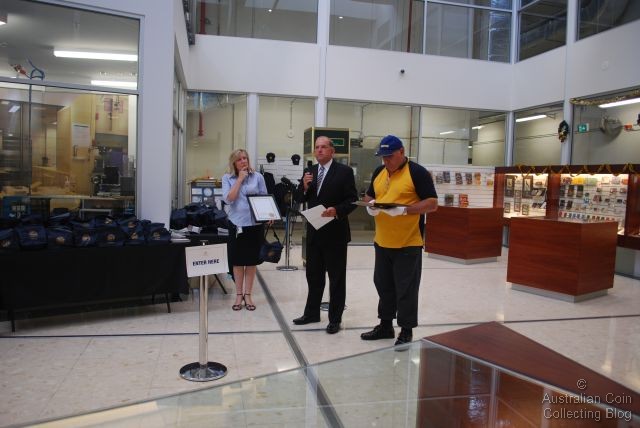 From left: Helen (Mint Shop Manager), Graham Smith (CEO) and 1st Visitor Bruce Mansfield
From left: Helen (Mint Shop Manager), Graham Smith (CEO) and 1st Visitor Bruce MansfieldWhilst being filmed by the news and with cameras flashing from every direction Bruce then struck the first coin on the gallery press for 2010. He donned his white gloves so as not to mark the coin, fed his $3 into the press and hit the button.
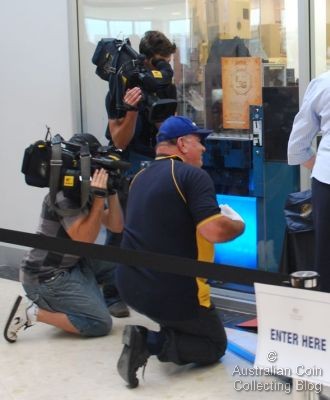 Bruce striking the first coin for 2010
Bruce striking the first coin for 2010The RAM was surprisingly crowded now and everyone else lined up in their numbered order to press 2 coins on the left hand gallery press and up to 5 coins each on the right hand press. The RAM set these odd limits on the day to reduce crowding and allow everyone their chance to mint a coin. Graham Smith made himself available and was friendly and willing to autograph folders or certificates. It was overall a fun and exciting experience but I won't be getting up so early next year.
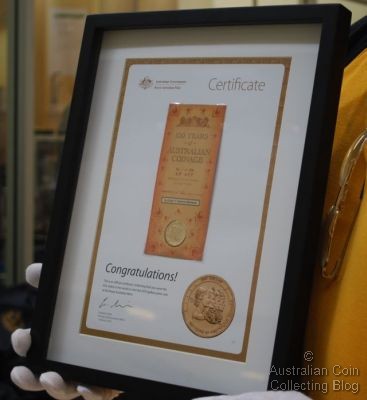 Framed Certificate Received by the First Visitor
Framed Certificate Received by the First VisitorThanks to our new friend Belinda for keeping us company in the queue for hours and the other collector/forum friends for some interesting coin discussions in the lineup!


